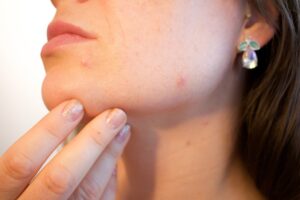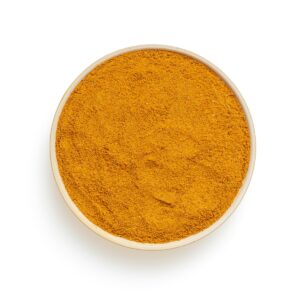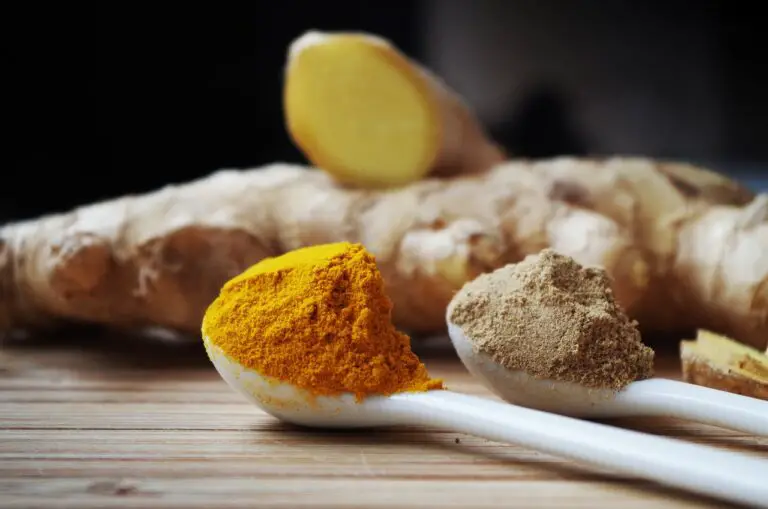When turmeric is brought up, we commonly think of aromatic curries and vivid lattes. Renowned in traditional medicine for its powerful attributes, this lively spice offers advantages beyond consumption, serving as a concealed ally for individuals contending with tenacious acne and skin well-being issues. Discover the potential of turmeric for acne-prone skin.
Understanding Acne-Prone Skin

Acne-prone skin is characterized by frequent breakouts, high levels of sebum production, and enlarged skin pores. This type of skin essentially becomes a breeding ground for acne-causing bacteria, known as propionibacterium acnes.
Contemporary acne treatment methods often require the use of harsh chemicals. These can sometimes exacerbate the problem, leading to further inflammation and skin discomfort. This is especially true for individuals with sensitive skin, who may find that the majority of products available on the market are too harsh for their complexions.
But there is hope for those feeling at a loss with their skincare woes. Before you give up with a heavy sigh, it’s time to delve deep into the treasure trove of natural treatments. It’s time to explore the potential of turmeric. This golden spice, steeped in history and tradition, could very well be the answer to treating acne, reducing sebum production, and improving overall skin health.
Unpacking the Potential of Turmeric for Acne-Prone Skin
Turmeric, the golden goddess of spices, has been a mainstay in Ayurvedic and traditional medicine. The secret lies within its active component, curcumin, which carries with it antioxidant, anti-inflammatory, and antibacterial properties that are a gamechanger for acne-prone skin. Curcumin, as several sources revealed, even holds an in vitro anti-propionibacterium acnes activity, which signifies it’s a potent force against the acne-causing bacteria.
A 2013 publication in “Chemical and Pharmaceutical Bulletin” found that turmeric extracts were able to decrease oil production by the sebaceous glands, indicating a potential use to treat acne among individuals suffering from excess sebum or excess oil.
These anti-inflammatory properties of turmeric also come into play in reducing the inflammation of acne lesions—an inflamed, red bump, ranging from mild to moderate acne. Turmeric steps in to calm the skin, working its magic within your skin cells.
Turmeric and Acne Scars

Turmeric’s benefits don’t stop at just treating acne, it’s also a powerhouse when it comes to managing acne scars. The miraculous skin brightening attributes of turmeric work wonders on reducing scarring.
Hyperpigmentation, a common aftermath of acne, can also be alleviated with the help of turmeric. It aids in evening out skin tone, giving your skin a vibrant, healthier appearance.
In essence, turmeric does more than just combat acne—it also plays a crucial role in improving your overall skin health and complexion.
DIY Turmeric Face Packs for Acne

Embarking on the turmeric for acne journey is incredibly simple. For those who can’t wait to reap turmeric’s goodness, here are some DIY turumeric face packs you can easily whip up at home:
1. Turmeric, Lemon Juice & Honey Face Pack – Blend a teaspoon of turmeric, a few drops of lemon juice and a teaspoon of honey. Gently apply on your face and leave it on for 15-20 minutes before rinsing. Turmeric, combined with the powerful vitamin C in lemon juice, assists in removing dead skin cells, while honey brings in its antibacterial properties for an all-round acne treatment.
2. Turmeric & Aloe Vera Gel Face Pack – Start with mixing two tablespoons of aloe vera gel with half a teaspoon of turmeric powder. Aloe Vera contains lauric acid which has antimicrobial properties that can help clear acne. Aloe vera gel also soothes the skin making the pack perfectly suitable for sensitive skin types.
3. Turmeric, Gram Flour & Sandalwood Powder Face Pack – Combine one teaspoon each of turmeric powder, gram flour, and sandalwood powder. Add a bit of rose water to create a thick paste. Apply this to the face and wash off after 20 minutes. Gram flour acts as an excellent exfoliator and helps eliminate dead skin cells. Sandalwood provides additional skincare benefits and helps brighten up your skin.
It’s important to note that turmeric could leave a compelling yellow tint on the skin. To avoid walking around looking like a radiant sun, it’s always best to apply these turmeric face packs at night before bedtime. Another tip—turmeric can stain clothing, so be mindful while applying.
Perfecting the turmeric treatment to get the bliss of clear skin does not strictly lie in external application alone. It’s crucial to also imbibe turmeric’s skin benefits internally to manage acne. Incorporating turmeric milk, also known as golden milk, into your diet can serve as a powerhouse of goodness. This vibrant concoction does more than just soothe, it brings to you the curcumin’s benefits in a warm, comforting mug.
Is Turmeric for Everyone?
Despite the many benefits, the mantra “one size fits all” doesn’t apply to skincare. Each individual’s skin responds differently to various treatments, and hence it’s crucial to consider your unique skin characteristics before adopting a new regimen.
Before you go all in and apply turmeric on your acne, it’s a good idea to do a patch test. This simple step can help rule out any allergic reactions. Apply a small amount of turmeric paste on your hand or forearm and wait for any signs of discomfort or redness.
Although rare, some people might experience contact dermatitis after applying turmeric. This allergic reaction might lead to a little redness, a rash, or even itchiness.
If you encounter these symptoms, it’s best to discontinue use. Be cautious and mindful, and always prioritize your skin’s health and comfort over pursuing new treatments. If you have any doubts, it doesn’t hurt to consult a dermatologist or healthcare provider.
Precautions and Possible Side Effects

Using turmeric for treating acne comes with its set of precautions. One of the crucial aspects to consider is that turmeric can act as a natural dye. This can leave a temporary stain on your skin, which might take a few washes to fade away.
In addition to the skin, be aware that turmeric can also stain your towels and clothes. It’s a good practice to use dark-colored towels when you’re rinsing off a turmeric face pack.
Lastly, while the benefits of turmeric for your skin are numerous, it’s important not to leave the mask on for much longer than required. Excessive application may risk drying out your skin or causing other discomforts. Make sure to follow the suggested timing for each mask to get the benefits without the side-effects.
So, should you turn to Turmeric for Acne?
After evaluating the compelling evidence presented in a number of studies, the golden spice, turmeric, acts as an affordable, natural, and effective remedy for those with acne-prone skin. Its anti-inflammatory properties, antimicrobial attributes, and the capacity to reduce sebum production make it a potent ally for individuals fighting the constant battle against acne.
Before we wrap this up, it’s critical to remember that as with all skincare treatments, consistency is key. Also, remember to maintain a balanced diet, hydrate often, and allow your skin to breathe. In the war against acne, consider turmeric your dependable comrade, battling with you, bringing you one step closer to clearer skin one day at a time.

